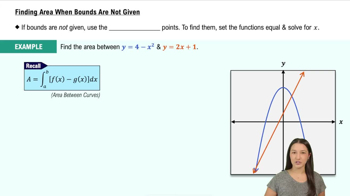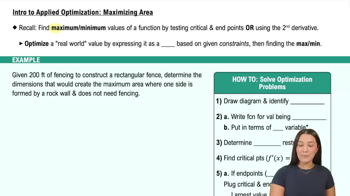Maximum printable area A rectangular page in a text (with width x and length y) has an area of 98 in² , top and bottom margins set at 1 in, and left and right margins set at 1/2 in. The printable area of the page is the rectangle that lies within the margins. What are the dimensions of the page that maximize the printable area?
Table of contents
- 0. Functions7h 54m
- Introduction to Functions16m
- Piecewise Functions10m
- Properties of Functions9m
- Common Functions1h 8m
- Transformations5m
- Combining Functions27m
- Exponent rules32m
- Exponential Functions28m
- Logarithmic Functions24m
- Properties of Logarithms36m
- Exponential & Logarithmic Equations35m
- Introduction to Trigonometric Functions38m
- Graphs of Trigonometric Functions44m
- Trigonometric Identities47m
- Inverse Trigonometric Functions48m
- 1. Limits and Continuity2h 2m
- 2. Intro to Derivatives1h 33m
- 3. Techniques of Differentiation3h 18m
- 4. Applications of Derivatives2h 38m
- 5. Graphical Applications of Derivatives6h 2m
- 6. Derivatives of Inverse, Exponential, & Logarithmic Functions2h 37m
- 7. Antiderivatives & Indefinite Integrals1h 26m
- 8. Definite Integrals4h 44m
- 9. Graphical Applications of Integrals2h 27m
- 10. Physics Applications of Integrals 3h 16m
- 11. Integrals of Inverse, Exponential, & Logarithmic Functions2h 31m
- 12. Techniques of Integration7h 41m
- 13. Intro to Differential Equations2h 55m
- 14. Sequences & Series5h 36m
- 15. Power Series2h 19m
- 16. Parametric Equations & Polar Coordinates7h 58m
5. Graphical Applications of Derivatives
Applied Optimization
Problem 63
Textbook Question
An isosceles triangle has its vertex at the origin and its base parallel to the x-axis with the vertices above the axis on the curve y = 27 - x2. Find the largest area the triangle can have.
 Verified step by step guidance
Verified step by step guidance1
Identify the vertices of the isosceles triangle. The vertex is at the origin (0,0), and the base is parallel to the x-axis. The other two vertices are on the curve y = 27 - x^2, so they are at points (x, 27 - x^2) and (-x, 27 - x^2).
Express the base length of the triangle. The base of the triangle is the distance between the points (x, 27 - x^2) and (-x, 27 - x^2), which is 2x.
Determine the height of the triangle. The height is the y-coordinate of the points on the curve, which is 27 - x^2.
Write the formula for the area of the triangle. The area A of a triangle is given by A = 1/2 * base * height. Substitute the expressions for the base and height: A = 1/2 * 2x * (27 - x^2).
Maximize the area function. Simplify the area expression to A = x * (27 - x^2) and find the derivative dA/dx. Set the derivative equal to zero to find critical points, and use the second derivative test or analyze the critical points to determine the maximum area.
 Verified video answer for a similar problem:
Verified video answer for a similar problem:This video solution was recommended by our tutors as helpful for the problem above
Video duration:
5mPlay a video:
Was this helpful?
Key Concepts
Here are the essential concepts you must grasp in order to answer the question correctly.
Area of a Triangle
The area of a triangle can be calculated using the formula A = 1/2 * base * height. In this context, the base of the isosceles triangle is determined by the x-coordinates of its vertices, while the height is the y-coordinate of the vertex at the origin. Understanding how to express the area in terms of these variables is crucial for maximizing it.
Recommended video:

Finding Area When Bounds Are Not Given
Quadratic Functions
The curve y = 27 - x² is a downward-opening parabola, which is a type of quadratic function. This function's maximum point occurs at its vertex, which is essential for determining the height of the triangle. Recognizing the properties of quadratic functions helps in analyzing the relationship between the triangle's dimensions and the curve.
Recommended video:

Introduction to Polynomial Functions
Optimization
Optimization in calculus involves finding the maximum or minimum values of a function. In this problem, we need to maximize the area of the triangle, which requires setting up a function for the area in terms of a variable and then using techniques such as taking derivatives and finding critical points to identify the maximum area.
Recommended video:

Intro to Applied Optimization: Maximizing Area

 1:13m
1:13mWatch next
Master Intro to Applied Optimization: Maximizing Area with a bite sized video explanation from Patrick
Start learningRelated Videos
Related Practice
Textbook Question
